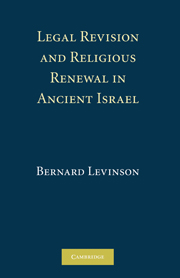
Nearly a week ago now, I had the opportunity to attend an SBL session devoted to the discussion of Bernard Levinson's book Legal Revision and Religious Renewal in Ancient Israel (reviewed on this blog here).
The panelists included David Wright, Christophe Nihan, and Beth Berkowitz with a response by Levinson himself. Wright and Nihan offered more traditional, straightforward reviews of the book with an overview of the content and some discussion of its strengths and weaknesses. Their reviews were generally positive - so much so that their minor criticisms and disagreements were not particularly memorable. Most disagreement seemed to stem from fundamental differences in perspective regarding the relationship between ancient Near Eastern texts, their authors, and their audiences.
The presentation by Beth Berkowitz was more creative and less traditional as a review. She demonstrated, convincingly in my opinion, how the later rabbinic exegetes further transformed the biblical text with similar goals of religious renewal, but she raised an important issue regarding whether the mode of textual transformation itself would not have also been transformed over time. I enjoyed her presentation the most as it gave me a chance to practice my rabbinic Hebrew (a Mischsprache par excellence, if there ever was one), and it reminded me of something that had jumped out at me on first reading Levinson's book. I find it completely plausible that the mode of textual transformation would have remained very similar over time. The same processes that worked to transform the Hebrew Bible in the Second Temple period and late antiquity in the Dead Sea Scrolls, the New Testament, and rabbinic literature were also at work among the tradents who transmitted the biblical text and shaped its canonical form. Even today, interpretation of sacred Scripture is a vital part of religious life; it is the essential work of making an ancient, out-of-date text relevant for contemporary life. The mode has not substantially changed, but the decisions on what is and is not Scripture have been made - differently by different groups all over the world.
Overall, the reaction to Levinson's book was positive and responses were generous in recognizing the important contribution he has made. The discussion time at the end, however, seemed dominated by some who seemed to have a fundamental misunderstanding of the central tenet of this book. This point could have been made more explicity--earlier texts were preserved because they had a measure of canonical authority. Later texts had to be subtly subversive to recast the reader's understanding of the earlier texts because they couldn't just make the earlier texts go away. I think Levinson's book demonstrates perfectly how that process was at work in the Hebrew Bible. Anyone involved in a living religious community will be able to see that the process is still at work today.
I was at that SBL session as well. I agree with your assessment (especially about Beth Berkowitz' presentation), with the exception of Levinson's thesis that, in your words, "the mode of textual transformation would have remained very similar over time."
ReplyDeleteMy rationale is simple: modes of textuality change(d), or rather multiply(-ied), over time, providing more options for those in the textual transmission business. Thus, while many of the transformational dynamics would be similar or even identical, it is reasonable to expect some change as well.
IMO, the feasibility of a transformation of textual transformation is what Beth Berkowitz demonstrated so well.
Carl Kinbar
Carl,
ReplyDeleteThanks for your feedback. I would say that what you quoted represents my thinking, not necessarily my attempt at representing Levinson.
I don't mean to imply that the mode itself remained static and unchanging. I agree that the details may change but the fundamental activity is the same. The more things change - the more we're going to act like nothing's changed at all.
I agree with your assessment that Beth Berkowitz demonstrated the "feasibility of a transformation of textual transformation." Maybe it's just semantics because I think that while the mode of activity may change, the essential underlying motivation of the activity seems to me to remain similar.
However, I will admit to being fuzzy on some of the details from that session. I intended to return to it much sooner than nearly a week later. That said, it's possible I misunderstood or have not fully recalled some parts of the discussion. I welcome any comments from anyone who can refresh my memory or clarify the issues from the panel more precisely. I should've taken notes.